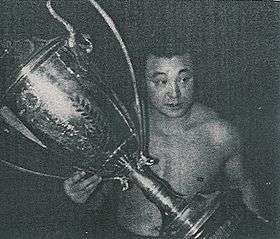Dewaminato Rikichi
| Dewaminato Rikichi | |
|---|---|
| 出羽湊 利吉 | |
|
| |
| Personal information | |
| Born |
Rikichi Satō March 20, 1907 Akita prefecture, Japan |
| Died | May 17, 1964 (aged 57) |
| Height | 1.77 m (5 ft 9 1⁄2 in) |
| Weight | 98 kg (216 lb) |
| Career | |
| Stable | Dewanoumi |
| Record | 197-158-35-1draw |
| Debut | March, 1928 |
| Highest rank | Sekiwake (January, 1937) |
| Retired | November, 1944 |
| Championships |
1 (Makuuchi), 1 (Jūryō), 1 (Makushita) |
| Gold Stars | 1 (Minanogawa) |
| * Up to date as of July 2013. | |
Dewaminato Rikichi (March 20, 1907, as Rikichi Satō in Akita Prefecture, Japan – May 17, 1964), was a professional sumo wrestler with Dewanoumi stable.
Career

He first entered the ring in the Summer 1928 tournament. In 1932, he was one of the few unsalaried wrestlers to be expelled from sumo by the JSA for being involved in a strike called the "Shunjūen Incident" that was largely unsuccessful. He, along with many others, was allowed back in from the Spring 1933 tournament. He was allowed into the makushita division, but unranked.[1] His hiatus seemed to have recharged his sumo, as he posted eight winning tournaments over four years from this point. In this period, he also took the makushita championship in the Summer 1933 tournament, and after entering jūryō, in the following tournament, took the jūryō championship with a perfect 11-0 record in the Summer 1934 tournament. He was promoted to the top division makuuchi for the Spring 1935 tournament. He managed to enter the titled ranks at sekiwake for the Spring 1937 tournament but only managed a 2-9 record and was back to the untitled ranks of maegashira. In the Spring 1938 tournament, though he only had a 2-5 record before pulling out due to injury, he still managed a gold star or kinboshi win over yokozuna Minanogawa, incidentally one of the leaders of the strike back in 1933. He had another losing tournament that he had to pull out of in Summer 1938. When he returned for the next tournament in the summer 1939 tournament at maegashira 17, he was on the cusp of relegation to the second division jūryō. He came back to life, posting a 13-0 record, including taking down future yokozuna Haguroyama and winning the championship. Because he was lower maegashira, he never had to face yokozuna Futabayama in this tournament, who ironically in this same tournament had his recording setting winning streak broken at 69 by Dewaminato's stablemate Akinoumi. The impact of Dewaminato's perfect championship, called a zenshō-yūshō was overshadowed by the fact that Futabayama had achieved seven consecutive zenshō-yūshō up to this point, and would bounce back to achieve yet another one in the following Summer tournament. Dewaminato fought on after this, managing to stay in the upper maegashira ranks, and even breaking into the titled rank of sekiwake for two consecutive tournaments in 1942-43. His fortunes began to decline after this however, and after losing all ten of his bouts in the Summer 1944 tournament, he retired before the start of the Autumn 1944 tournament.
He served as a sumo elder after this until his death in 1964 at the age of 57.
Career record
| - | Spring Haru basho, Tokyo |
March Sangatsu basho, varied |
Summer Natsu basho, Tokyo |
October Jūgatsu basho, varied |
|---|---|---|---|---|
| 1928 | x | x | (Maezumo) | Jonokuchi
– |
| 1929 | West Jonidan #40
6–0 |
West Jonidan #40
4–2 |
East Sandanme #29
3–3 |
East Sandanme #29
4–2 |
| 1930 | East Sandanme #12
4–2 |
East Sandanme #12
3–3 |
West Makushita #29
2–4 |
West Makushita #29
5–1 |
| 1931 | West Makushita #12
1–5 |
West Makushita #12
2–4 |
West Sandanme #2
5–1 |
West Sandanme #2
4–2 |
| 1932 | Expelled | Expelled | Expelled | Expelled |
| - | Spring Haru basho, Tokyo |
Summer Natsu basho, Tokyo |
Autumn Aki basho, Tokyo |
|||
|---|---|---|---|---|---|---|
| 1933 | Makushita
7–2 |
East Makushita #7
8–3 Champion |
Not held | |||
| 1934 | East Jūryō #10
7–4 |
East Jūryō #3
11–0 Champion |
Not held | |||
| 1935 | West Maegashira #9
6–5 |
West Maegashira #7
6–5 |
Not held | |||
| 1936 | East Maegashira #5
8–3 |
West Maegashira #1
7–4 |
Not held | |||
| 1937 | East Sekiwake
2–9 |
East Maegashira #3
7–6 |
Not held | |||
| 1938 | East Maegashira #2
2–5–6 ★ |
East Maegashira #9
3–5–5 |
Not held | |||
| 1939 | West Maegashira #17
13–0 |
West Komusubi
5–10 |
Not held | |||
| 1940 | West Maegashira #8
8–7 |
West Maegashira #2
10–5 |
Not held | |||
| 1941 | East Komusubi
0–2–13 |
East Maegashira #5
9–6 |
Not held | |||
| 1942 | West Maegashira #1
9–6 |
West Sekiwake
8–6 1d |
Not held | |||
| 1943 | East Sekiwake
3–12 |
West Maegashira #4
7–8 |
Not held | |||
| 1944 | East Maegashira #4
8–6–1 |
West Maegashira #2
0–10 |
West Maegashira #15
Retired 0–0–10 |
|||
| Record given as win-loss-absent Top Division Champion Retired Lower Divisions Key: ★=Kinboshi(s); d=Draw(s) (引分); h=Hold(s) (預り) | ||||||
See also
- Glossary of sumo terms
- List of past sumo wrestlers
- List of sumo tournament top division champions
- List of sumo tournament second division champions
References
- ↑ Kuroda, Joe (August 2006). "Rikishi of Old: Tenryu Saburo and Shunjuen Incident". sumofanmag.com. Retrieved 12 July 2013.
- ↑ "Dewaminato Rikichi Rikishi Information". Sumo Reference. Retrieved 2013-07-12.